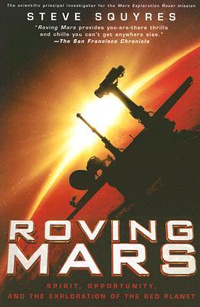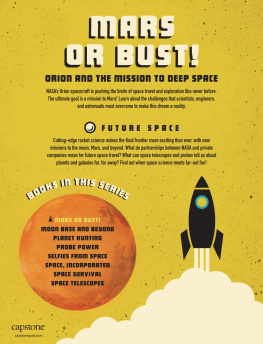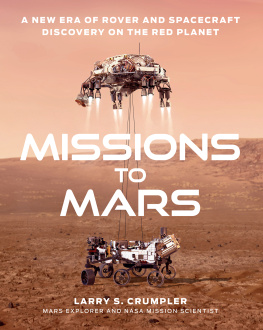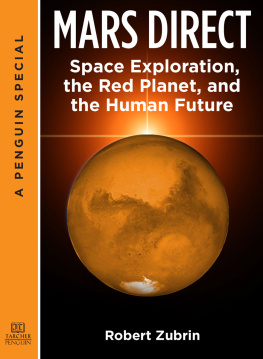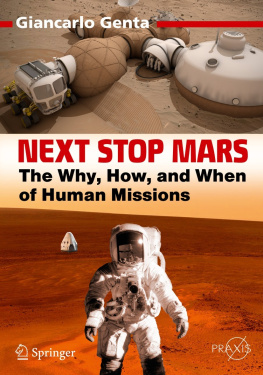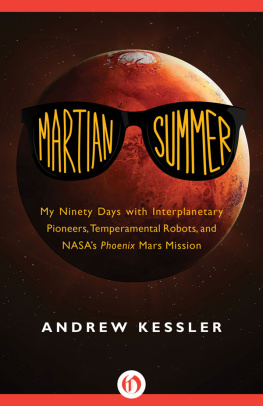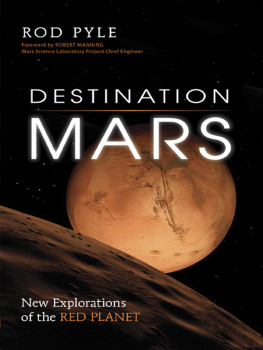STEVE SQUYRES
ROVING MARS
Spirit, Opportunity, and the Exploration of the Red Planet

To Joe, Ray and Carl
Contents
The most difficult part of writing this book was deciding what to leave out. The Mars Exploration Rover project was the work of literally thousands of dedicated, talented and passionate people. Its impossible to tell all of their stories in a book of this length, or even to hint at the full richness and complexity of their contributions. Indeed, many people without whom the mission could not have succeeded do not even appear in these pages. The inspired leadership of a Matt Wallace, the performance under pressure of a Glenn Reeves and the scientific insight of a John Grotzinger were matched thousands of times over, for many years, in stories equally deserving of telling. The few people here whose stories I do tellthe characters in this bookare also surrogates for uncounted others who did as much.
Many people gave generously of their time and effort to help me write this book. Mark Adler shared his detailed notes of some of the earliest days of the project. Leo Bister, Ralf Gellert, Steve Gorevan, Randy Lindemann, Rob Manning, Tom Myrick, Glenn Reeves, Adam Steltzner and Matt Wallace all sat for long interviews, telling their stories and patiently explaining the details of their work. John Beck gave me unlimited access to many hours of video footage that he shot during flight operations, helping enormously in getting the details of dialogue right. Many people on the project contributed snapshots for the photo inserts; their names are given in the photo credits.
Gentry Lee, Charles Elachi, Pete Theisinger, Barry Goldstein and Mark Adler all reviewed the entire manuscript, checking for technical errors and giving me good literary advice. Where mistakes remain the fault is mine, and where I have not followed their advice it has been at my own peril.
Peter Matson at Sterling Lord Literistic was an early believer in this book, and Gretchen Young at Hyperion came on board quickly and provided sound editorial guidance. Zareen Jaffery kept me on the straight and narrow, providing gentle prodding on the many occasions when I needed it. Pam Smith took on the Herculean task of pulling together our best attempt at a list of everyone who worked on the MER project.
The people who really have kept me sane through this story and its telling were my family. I owe my deepest thanks to my wife, Mary, and to our two daughters, Nicky and Katy. The MER project, for me, has lasted seventeen years, and there was not a moment in all that time when I did not know that I had my familys unqualified love and support. They made my contribution to the project possible, and I am more grateful to them than I can say. Youve heard the expression that someone married well? I married well.
As I write this, we are now 445 days into our 90-day mission to Mars. The adventure continues, and each day Spirit and Opportunity bring us new discoveries. What I really wish I could do in these acknowledgments, with all of the depth and sincerity that they deserve, is individually thank every one of my friends, colleagues and comrades on the MER project who made these discoveries possible. The book itself must stand as my attempt to do so.
Ithaca, New York
April 4, 2005
When I was a kid, I loved maps. Still do. I grew up in the sixties, and in those days if you looked at a not-so-current atlas of the world, you could still find a few blank spotsplaces that were understood poorly enough by the mapmakers that they didnt know what to draw. I loved the idea of a map that wasnt done yet, with places on it still to be discovered. As a boy, I read everything I could get my hands on about explorationAmundsen and Scott in the Antarctic, Beebe and Barton in the deep seatracing their adventures across my maps and dreaming about the exploring Id do myself someday.
By the time I hit college, reality set in. There were no blank spots on the maps anymore. I was a student at Cornell University, in upstate New York. I loved climbing mountains and I had a knack for science, so I picked geology as a major, thinking that it might be a way to get paid to go climbing. After learning a little bit of geology I started to drift toward something involving exploration of the sea floor, since there were still some blank spots there. But it wasnt working for me. The geologists who have spent the last two centuries studying our planet, it turns out, have done a pretty darn good job of it. To me, geology felt like filling in details.
Then, early in the spring of my junior year, I was giving my girlfriend a tour of the Cornell campus. This was in 1977, just after NASAs Viking spacecraft had arrived at Mars, and while we were in the Space Sciences building she spotted a three-by-five card tacked to a bulletin board, announcing that a professor who was a member of the Viking science team was going to be teaching a graduate seminar course on Mars. What the hell, I thought, and I went.
I started by nearly getting kicked out of class. The first thing the professor asked when we were all in our seats was Are there any undergraduates here? One timid hand went upmineand he asked me to see him after the lecture. It was pretty obvious he was going to throw me out. What saved me was that one of my would-be classmates was a grad student from the geology department who knew both me and the prof, and who came over at the crucial juncture and vouched as best he could for my studious nature. The prof assented, though not without making it clear why he didnt like having undergrads in the course. If Im talking about temperatures on Mars, he said, I dont want to have to stop and explain to the whole class what thermal diffusivity is. I nodded sagely, and ran back to my dorm room to look up thermal diffusivity.
Because the course was taught at the graduate level, we were expected to do some kind of original research project for our grade. A few weeks into the semester I figured Id better start thinking about what I was going to do for my term paper, so I asked for a key to the Mars Room, where all of the new pictures from the Viking orbiters were being kept. I found the Mars Room in Clark Hall, behind the Space Sciences building. It was a deserted and disorderly place, more like a warehouse than a scientific data archive. A few of the pictures that had been taken during the earliest part of the mission were in glossy blue three-ring binders, arranged in chronological order on gray-painted steel shelves. Most, though, were on long rolls of photographic paper, stacked on the floor or still in their shipping cartons. My idea had been to spend fifteen or twenty minutes flipping through pictures, hoping to find inspiration for a term paper topic. Instead, I was in that room for four hours, racing through the pictures, stunned. I understood almost nothing that I saw, of course, but that was the beauty of it. Nobody understood most of this stuff. In fact, only a handful of people in the world had even seen it yet. Sitting there cross-legged on the linoleum, I was exploring a new, distant and alien world. I walked out of that room knowing exactly what I wanted to do with the rest of my life.
The planet that I saw in those pictures is a beautiful, terrible, desolate place. Its cold: The average temperature on Mars is sixty degrees below zero centigrade. Its dry: If you could take all the water vapor in the martian atmosphere and freeze it out on the planets surface, the layer of ice you would make would be barely a hundredth of a millimeter thick. The thin carbon dioxide atmosphere of Mars whips dust off the ground into storms that can darken the skies for months at a time. The planet that we see as a shining red point of light in the night sky of Earth is a barren, hostile world.
Next page
